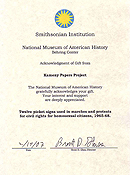 |
The Kameny Papers Project received this certificate from the Smithsonian Institution:
|
Archive Activism: The story behind The Kameny Papers Project Remarks Thank you for the invitation to address your unique LGBT caucus within the Special Libraries Association. It is exciting to speak before a group of librarians and researchers who work for Fortune 100 companies, think tanks, universities and research services. You totally understand the value of archives and in-depth research, and have a unique perspective on how this intersects with LGBT issues. Looking back on the Frank Kameny Papers Project--- our effort to save and secure one of the great collections of LGBT history---I now realize saving and conserving a gay archive or primary material is a kind of activism. We think of history as text. We think of history as something that exists. The granddaddy of all LBGT Special Library Collection was thrown into a bonfire. I will never forget visiting the site of the Nazi book bonfire in front of Humboldt University in Berlin. Thousands of books written by, and about, so-called “degenerates” were looted, then burned, from Magnus Hirschfeld’s special library at his Institute for Sexual Research. In its day, this was the largest collection of books about homosexuality. The year was 1933. What if history depends not upon “great historians”, but upon that one special person with the self-awareness and the self-respect to actually save something that matters? Someone alienated enough, yet engaged enough, to actually isolate an artifact, and protect it. Additionally, this person has to have a “room of one’s own”---a safe and secure place where the scrapbook or cache of letters can be protected not for a couple of years, but decades. Long enough to escape the clutches of an often hostile society. I hate to think how much gay and lesbian primary material over the centuries has been torched and destroyed by a homophobic or ignorant public. These could be letters discarded by an embarrassed or protective relative. These could be documents and books destroyed by a hostile governmental authority. Precious artifacts and materials are destroyed by gay writers themselves who remain closeted. Thus, the story of the Kameny Papers is a miracle in itself. It begins in the attic of Frank Kameny, one founder of the modern gay movement for civil equality. There, I found more than 150 boxes of materials, scores of pickets, memorabilia, books and letters. It is a goldmine of gay history, triggered by Frank’s dismissal by the Federal Government in 1957, when the government discovered he was gay. The archive exceeds 50,000 documents. Frank is a “packrat”, maybe a bit of an obsessive ‘hoarder’. His house, when I originally entered, was floor-to-ceiling papers and books. It was like walking into a looking glass of activism, back into the 1950s. There were so many papers, I could only ask that he sort them by the foot. I would literally measure the feet with a carpenter’s tape measure, for the appraiser’s review.
This image of a blackmailer on the prowl in Dupont is as creepy as it is unforgettable. How could a blackmailer in Dupont thrive, I wondered, without an atmosphere of secrecy difficult to imagine today----unless one is serving in the military! A second document, among the thousands, is a letter to Frank Kameny, dated 1961, from one John W. Macy, Jr., Chairman of the U.S. Civil Service Commission. It reads:
For too long, opponents of gay civil equality have waved away the soul-crushing discrimination faced by Kameny’s generation. “ It just did not happen”. But, let’s be clear: far more patriotic homosexuals were ruined in the Cold War era than alleged Communists. A letter like John Macy’s is a precious artifact of imbedded state hostility that today cannot meet any rational basis judicial test. Finally, there is this letter from John W. Hanes, Jr., the Administrator of the Bureau of Security and Consular Affairs at the State Department in 1960. First, let me tell you a little bit about John Hanes so you can fully appreciate his letter. John Hanes, Jr., was an heir to a North Carolina textile fortune known today for the underwear ads that bear his name. Born in New York City, he attended Deerfield and Yale. He enjoyed a years-long, close working relationship with John Foster Dulles, President Eisenhower’s Secretary of State. Dulles was a giant of his time and is credited as one of the architects of containment, massive retaliation and the Cold War itself, not to mention the founding of the United Nations. John Hanes served as “Special Assistant” to this man. Now comes Frank Kameny, putt-putting down this “autobahn of power”. Hanes must have seen Kameny as a speck on the fringe-of-the -fringe. Still, Security issues are Hanes’ specialty; and Frank was in the process of inventing himself as a public homosexual with a grievance. So Hanes probably thought he had a clean shot. Here is what John Hanes wrote Frank in 1960: “Dear Mr. Kameny, It should be perfectly apparent to you, as it was to me upon receipt of your first letter, that I am unable to make any reply that will be satisfactory to you. “ “You are as aware as I “, Hanes lectures, “of the reasons why the Department of State does not hire homosexuals and will not permit their employment..…..The homosexual is automatically a security risk because of social and emotional pressure to which he is subject from society and because of the ever present risk that such pressures can be utilized by hostile elements….”. Hanes continues:
Hanes felt he had the standing to write a letter like this, condescending, lecturing, condemning. His language and tone display his status at the apex of Washington power-----and the homosexual’s criminal and “infamous” position at the outer fringes of nowhere. In 2006, we met with the 20th Century Political Historian of the Library of Congress Manuscript Division. I wasn’t sure what he would think, given the fact that the Library had no openly gay collection; of course they have Walt Whitman and so many others, but no self-identified modern gay or lesbian collection. To his credit, he recognized Frank’s archive as an important find. He wrote me a letter expressing the Library’s interest in the Kameny papers. It said:
The Letter from the Library of Congress concluded: “The Manuscript Division of the Library would provide a permanent archival home for the papers and its archivists would organize the Kameny papers for preservation and historical research and make them available to researchers in the Manuscript Reading Room of the Library”. Reading this clear statement from the Library of Congress that was not “de-gayed” or couched in euphemism is one of the greatest moments of my life in Washington, D.C. I could literally feel the doors of the Library, the doors of history, swinging open to the thousands whose lives were destroyed. I encourage you to visit the Library where you may read about these lives in the Kameny papers. These are the stories of people labeled “perverts”, declared security risks and fired or discharged or blackmailed. These are the people who had been hunted down by their government and called “deviates” by the media. These are the gay men and women declared insane by the psychiatric establishment. These are the gays and lesbians who served in World War II, as did Kameny, and who serve so bravely today under terrible discrimination. They all walked into the Library of Congress with Frank. After the success of the Kameny Papers Project, the artifacts and primary materials that tell our stories will have a far greater chance of survival, study and exhibition to the public. Libraries across the country will have a much harder time “de-gaying” their collections. The New York Public Library acquired the archive and photographs of Barbara Gittings and Kay Tobin Lahusen. The Hormel Collection of the San Francisco Public Library is so excellent. The Fort Lauderdale Public Library has an excellent gay collection, as does Yale, and the University of Southern California in partnership with the ONE archive in Los Angeles. Aging gay and lesbian boomers will be far more conscious of their history and their legacy, and will leave money to institutions such as these that will conserve and interpret our collections. In fact, plans are underway now for a privately-funded LGBT history museum here in Washington. It will be called, “The National Museum of American LGBT History & Culture”. We must help educate our libraries and the constituencies they serve. LGBT stories are part of the fabric of American life. The day we delivered the 1966 White House pickets to the Smithsonian Institution, we were met by Dr. Brent Glass, the President of the National Museum of American History, and Harry Rubenstein, who heads the Politics and Reform section of the National Museum of American History. Harry began explaining how the pickets fit into the Smithsonian collection. He put on a pair of white gloves and removed from a cabinet what looked like a box wrapped in green velvet….and he put the box down beside the signs. Opening the velvet, he said, “This is the lap desk where Thomas Jefferson wrote the Declaration of Independence”. He put forward another object. It was an inkwell. “This is the inkwell President Lincoln used to write The Emancipation Proclamation.” Harry pulled from another cabinet a small silver pin in the shape of a jail cell door with the inscription: “Jailed for Freedom”. Harry explained this pin was worn by Suffragist Alice Paul when she and her cohorts were hauled to jail repeatedly for daring to picket President Wilson’s White House in 1917, demanding the vote. Frank was visibly moved seeing American “holy relics” like these alongside the old picket signs carried forty years earlier . The message from the Smithsonian curator was a clear one: the gay and lesbian papers and pickets do not exist in a world apart from the American story; they actually embody and renew America’s story. This archive documents a piece of the great expansion of liberty in the United States, an arc that runs from Jefferson to Lincoln to Alice Paul to King, to Kameny…. a promise for us all. Thank you.
|

